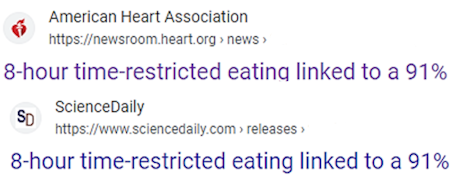Time-Restricted Eating or Intermittent Fasting Linked to 91% Higher Deaths
May 05 2024
This recent paper was all over the media, showing that time-restricted eating was linked with a shocking 91% increase in heart disease-related deaths.
What is time-restricted eating?
It is a form of intermittent fasting where you restrict your food intake to a short time frame during the day, say 8 hours or less, and fast for the remaining hours.

What did the study show?
Briefly, the study involved 20,000 US adults providing data on what they ate, and at what times, over a 24-hour period on two separate occasions from 2003 to 2018. The study was a poster for the American Heart Association’s Epidemiology of Prevention conference in Chicago in March 2024. So the paper hasn’t gone through peer review.
Increase in Deaths: People who restricted eating to less than 8 hours per day were associated with a 91% greater number of deaths due to heart-related diseases compared to folks who followed a traditional pattern of eating their food across 12 to 16 hours each day.

What does 91% increase in deaths mean?
The only reason this was picked by media is due to the large increase in mortality of 91%. But isn’t 91% a huge increase in deaths???
- Relative Risk (IRR): The risk here is presented in relative terms. It means the risk is almost 100% greater than/relative to the control group, which sounds huge. Relative risk always tends to exaggerate the risk more than what it actually is.
- Absolute Risk (AR): The best way to communicate risk is using absolute risk. Here the absolute risk difference (unadjusted) is 3.9% or 4%, which means out of 100 people, TRE is linked to 4 more deaths in 8 years. It clearly doesn’t sound so shocking, right? And if the results were expressed in AR, this study would have never made the headlines.
- AR vs RR example: If there was 1 death in the control group out of 100 and just 2 deaths in the diet group of 100, the relative risk (dividing risk in diet grp. by control grp) is 2.0, which represents a 100% increase in deaths. The absolute risk difference is 1% (calculated by subtracting control risk from diet grp. risk). So a 100% increase in deaths was actually just one more death compared to the control group!

So many experts in so many news articles and Twitter commented about reverse causation, confounding, low sample sizes, and self-reporting of dietary habits, problems with observational studies, but not even a single person ever bothered to express risk in absolute terms. Hence the reason for this short, but important post.
Conclusions
- Time-restricted eating was ‘associated’ with a 4% increase or simply 4 more deaths in 8 years.
- Next time you hear about ‘impressive’ changes in risk, ask for absolute changes.



